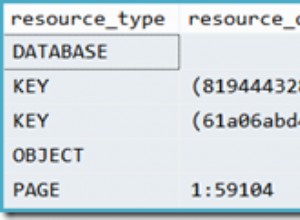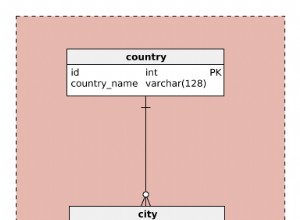Después de la aclaración en el comentario.
Tu tarea tal como la entiendo:
Comprobar todos los individuos suministrados intervalos de fechas (filter ) si están cubiertos por el combinado intervalos de fechas de conjuntos de códigos en su tabla (invoice ).
Se puede hacer con SQL simple, pero no es una tarea trivial . Los pasos podrían ser:
-
Proporcione intervalos de fechas como filtros.
-
Combinar rangos de fechas en
invoicetabla por código. Puede dar como resultado uno o más rangos por código. -
Busque superposiciones entre filtros y facturas combinadas
-
Clasificar:totalmente cubierto/parcialmente cubierto. Puede resultar en una cobertura total, una o dos coberturas parciales o ninguna cobertura. Reducir al nivel máximo de cobertura.
-
Muestre una fila para cada combinación de (filtro, código) con la cobertura resultante, en un orden de clasificación sensato
Rangos de filtro ad hoc
WITH filter(filter_id, startdate, enddate) AS (
VALUES
(1, '2012-05-01'::date, '2012-06-05'::date) -- list filters here.
,(2, '2012-05-01', '2012-05-31')
,(3, '2012-06-01', '2012-06-30')
)
SELECT * FROM filter;
O ponlos en una mesa (temporal) y usa la mesa en su lugar.
Combina intervalos de fechas superpuestos/adyacentes por código
WITH a AS (
SELECT code, startdate, enddate
,max(enddate) OVER (PARTITION BY code ORDER BY startdate) AS max_end
-- Calculate the cumulative maximum end of the ranges sorted by start
FROM invoice
), b AS (
SELECT *
,CASE WHEN lag(max_end) OVER (PARTITION BY code
ORDER BY startdate) + 2 > startdate
-- Compare to the cumulative maximum end of the last row.
-- Only if there is a gap, start a new group. Therefore the + 2.
THEN 0 ELSE 1 END AS step
FROM a
), c AS (
SELECT code, startdate, enddate, max_end
,sum(step) OVER (PARTITION BY code ORDER BY startdate) AS grp
-- Members of the same date range end up in the same grp
-- If there is a gap, the grp number is incremented one step
FROM b
)
SELECT code, grp
,min(startdate) AS startdate
,max(enddate) AS enddate
FROM c
GROUP BY 1, 2
ORDER BY 1, 2
SELECT final alternativo (puede ser más rápido o no, tendrás que probar):
SELECT DISTINCT code, grp
,first_value(startdate) OVER w AS startdate
,last_value(enddate) OVER w AS enddate
FROM c
WINDOW W AS (PARTITION BY code, grp ORDER BY startdate
RANGE BETWEEN UNBOUNDED PRECEDING AND UNBOUNDED FOLLOWING)
ORDER BY 1, 2;
Combinar en una consulta
WITH
-- supply one or more filter values
filter(filter_id, startdate, enddate) AS (
VALUES
(1, '2012-05-01'::date, '2012-06-05'::date) -- cast values in first row
,(2, '2012-05-01', '2012-05-31')
,(3, '2012-06-01', '2012-06-30')
)
-- combine date ranges per code
,a AS (
SELECT code, startdate, enddate
,max(enddate) OVER (PARTITION BY code ORDER BY startdate) AS max_end
FROM invoice
), b AS (
SELECT *
,CASE WHEN (lag(max_end) OVER (PARTITION BY code ORDER BY startdate)
+ 2) > startdate THEN 0 ELSE 1 END AS step
FROM a
), c AS (
SELECT code, startdate, enddate, max_end
,sum(step) OVER (PARTITION BY code ORDER BY startdate) AS grp
FROM b
), i AS ( -- substitutes original invoice table
SELECT code, grp
,min(startdate) AS startdate
,max(enddate) AS enddate
FROM c
GROUP BY 1, 2
)
-- match filters
, x AS (
SELECT f.filter_id, i.code
,bool_or(f.startdate >= i.startdate
AND f.enddate <= i.enddate) AS full_cover
FROM filter f
JOIN i ON i.enddate >= f.startdate
AND i.startdate <= f.enddate -- only overlapping
GROUP BY 1,2
)
SELECT f.*, i.code
,CASE x.full_cover
WHEN TRUE THEN 'fully covered'
WHEN FALSE THEN 'partially covered'
ELSE 'invoice missing'
END AS covered
FROM (SELECT DISTINCT code FROM i) i
CROSS JOIN filter f -- all combinations of filter and code
LEFT JOIN x USING (filter_id, code) -- join in overlapping
ORDER BY filter_id, code;
Probado y funciona para mí en PostgreSQL 9.1.




